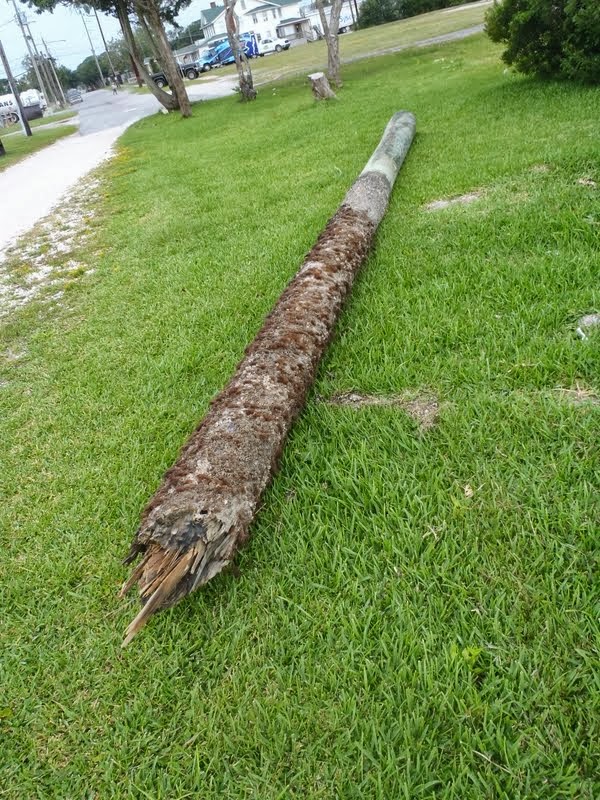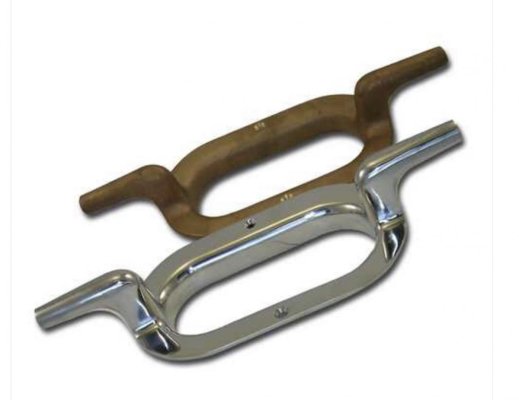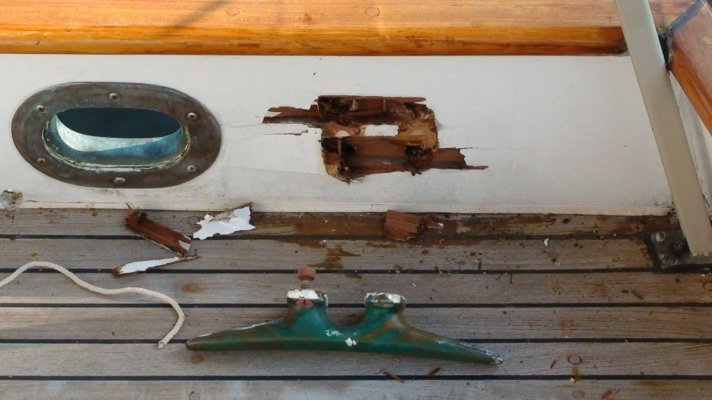You are using an out of date browser. It may not display this or other websites correctly.
You should upgrade or use an alternative browser.
You should upgrade or use an alternative browser.
Hurricane Lines?
- Thread starter ERTF
- Start date
The friendliest place on the web for anyone who enjoys boating.
If you have answers, please help by responding to the unanswered posts.
If you have answers, please help by responding to the unanswered posts.
sdowney717
Guru
- Joined
- Jan 26, 2016
- Messages
- 2,264
- Location
- United States
- Vessel Name
- Old Glory
- Vessel Make
- 1970 Egg Harbor 37 extended salon model
I used some 1" flexible white pvc hose and passed that over the 3/4" dock line aft tie up where it passes through chocks. But it does tend to slip down the line. Maybe put another line wrapped around and tied to stop it moving, I really dont know if that helps prevent chafing. The line can still move inside the rubber hose. But it was free. The sock idea using the chafe pro sounds like a very good idea.
The hose does protect the line from wearing at chocks in non major storm conditions. A huge storm though, lines can overheat and break, and the hose is not a good idea then if it keeps cooling water away from the line, but it is pouring rain on a line and water is going to pass right down that rope.
The hose does protect the line from wearing at chocks in non major storm conditions. A huge storm though, lines can overheat and break, and the hose is not a good idea then if it keeps cooling water away from the line, but it is pouring rain on a line and water is going to pass right down that rope.
Last edited:
firstbase
Guru
- Joined
- Nov 6, 2016
- Messages
- 1,644
- Location
- United States
- Vessel Name
- Black Eyed Susan
- Vessel Make
- Grand Banks 42' Classic
Oh, Ok. gotcha. I live too close to Disney. Makes one think strange things.
OldDan1943
Guru
- Joined
- Oct 2, 2017
- Messages
- 10,599
- Location
- USA
- Vessel Name
- Kinja
- Vessel Make
- American Tug 34 #116 2008
My permanent forward dock lines..... chain around shore cleats, lines attached to the chain with the appropriate thimble. Cleated on board. The boat cleats, on top of the hull with backing plates. Midship lines to keep it centered in the slip.
One can do only so much and ideally, that 'so much' will be be proper and enough.
One can do only so much and ideally, that 'so much' will be be proper and enough.
rgano
Guru
- Joined
- Oct 8, 2007
- Messages
- 4,995
- Location
- USA
- Vessel Name
- FROLIC
- Vessel Make
- Mainship 30 Pilot II since 2015. GB-42 1986-2015. Former Unlimited Tonnage Master
Can someone tell me what "hawse holes with ears" is exactly? Know what a hawse hole is but...ears?
Unfortunately, there is only the bulwark it is attached to for support, quite unlike a stout deck cleat with an adequate backing plate.
rgano
Guru
- Joined
- Oct 8, 2007
- Messages
- 4,995
- Location
- USA
- Vessel Name
- FROLIC
- Vessel Make
- Mainship 30 Pilot II since 2015. GB-42 1986-2015. Former Unlimited Tonnage Master
While not impossible, I doubt the Taiwan trawlers I tend to see these things on are built with bulwarks as strong as the same boats' decks.
sdowney717
Guru
- Joined
- Jan 26, 2016
- Messages
- 2,264
- Location
- United States
- Vessel Name
- Old Glory
- Vessel Make
- 1970 Egg Harbor 37 extended salon model
At 8:40, out come the rubber hoses. The snubber line chafed through.
That seems to have helped them. But this Hurricane Sandy event for them was not that major of a hurricane experience compared to many which are far worse.
That seems to have helped them. But this Hurricane Sandy event for them was not that major of a hurricane experience compared to many which are far worse.
oscar
Guru
- Joined
- Oct 22, 2015
- Messages
- 1,098
- Location
- United States
- Vessel Name
- Lady Kay V
- Vessel Make
- 1978 Hatteras 53MY
I've heard of people using liberal amounts of Sailkote dry lubricant on the lines....
https://www.westmarine.com/buy/mclube--sailkote-high-performance-dry-lubricant-8-oz--17757741
https://www.westmarine.com/buy/mclube--sailkote-high-performance-dry-lubricant-8-oz--17757741
Sailor of Fortune
Guru
Hate those hawse cleats..personal bias!
psneeld
Guru
Maybe, maybe not ....but just how strong does it need to be?While not impossible, I doubt the Taiwan trawlers I tend to see these things on are built with bulwarks as strong as the same boats' decks.
Not every boat or everything on a boat has to be invincible....just good enough for intended purpose.
OldDan1943
Guru
- Joined
- Oct 2, 2017
- Messages
- 10,599
- Location
- USA
- Vessel Name
- Kinja
- Vessel Make
- American Tug 34 #116 2008
My N46 had those cleats. Tied up for one hurricane, bent one ear.
Comodave
Moderator Emeritus
- Joined
- Jul 2, 2015
- Messages
- 21,297
- Location
- Au Gres, MI
- Vessel Name
- Black Dog
- Vessel Make
- Formula 41PC
I don’t care for the hawse cleat because you have a hard time getting 2 lines on them. Prefer a regular open base cleat.
BruceK
Moderator Emeritus
- Joined
- Oct 31, 2011
- Messages
- 13,347
- Vessel Name
- Sojourn
- Vessel Make
- Integrity 386
One dockline passes around a wooden post, we slid on a length of poly pipe to protect it. The pipe is secured by opening up the line strands either end of the desired pipe location and inserting a short length of light line across/through the dockline. It has worked for several years, with no problem. We got the idea from a similarly protected permanent mooring ball bridle set up by a mooring contractor, who could splice one handed while smoking a cigarette and observing cloud formations.I used some 1" flexible white pvc hose and passed that over the 3/4" dock line aft tie up where it passes through chocks. But it does tend to slip down the line. Maybe put another line wrapped around and tied to stop it moving, I really don`t know if that helps ....
firstbase
Guru
- Joined
- Nov 6, 2016
- Messages
- 1,644
- Location
- United States
- Vessel Name
- Black Eyed Susan
- Vessel Make
- Grand Banks 42' Classic
Cleat extenders. I read about using Dyneema loops in (too me) frighteningly small diameter, 3/8" and then bowlines to connect additional dock lines. Does anyone use something like this? 5/8" 3 strand? Something?
sdowney717
Guru
- Joined
- Jan 26, 2016
- Messages
- 2,264
- Location
- United States
- Vessel Name
- Old Glory
- Vessel Make
- 1970 Egg Harbor 37 extended salon model
One dockline passes around a wooden post, we slid on a length of poly pipe to protect it. The pipe is secured by opening up the line strands either end of the desired pipe location and inserting a short length of light line across/through the dockline. It has worked for several years, with no problem. We got the idea from a similarly protected permanent mooring ball bridle set up by a mooring contractor, who could splice one handed while smoking a cigarette and observing cloud formations.
I see, that could work fine. Good idea.
rgano
Guru
- Joined
- Oct 8, 2007
- Messages
- 4,995
- Location
- USA
- Vessel Name
- FROLIC
- Vessel Make
- Mainship 30 Pilot II since 2015. GB-42 1986-2015. Former Unlimited Tonnage Master
Hey, you guys with chafing issues, think about the use of a braided snubber to assist you in handling the situation. By all means, use your conventional anti-chafe guards on your mooring lines, but use of a snubber, just like you use for your anchor rode, is a great idea too. Again, as I have stated many times, a braided snubber will gip a mooring line outboard of the chafing material to take on some of the strain. You can put chafing material on the snubber too. If you allow more strain on the snubber than the mooring line, you can use it as a sentinel line to chafe/part before the main line giving you time to throw on another snubber before damaging the longer and more valuable mooring line. Stay safe!
OldDan1943
Guru
- Joined
- Oct 2, 2017
- Messages
- 10,599
- Location
- USA
- Vessel Name
- Kinja
- Vessel Make
- American Tug 34 #116 2008
for my N46, I had chains, lines and thimbles for my permanent dock lines. The bow lines to the cleats, the stern lines, same, (longer chains) lines, (no thimbles - 7/8 inch lines and dropped the chains and lines down to the bottom - no flexing of stern pilings. Storm lines, smaller diameter and looped the piling about mid height. Very secure.
rgano
Guru
- Joined
- Oct 8, 2007
- Messages
- 4,995
- Location
- USA
- Vessel Name
- FROLIC
- Vessel Make
- Mainship 30 Pilot II since 2015. GB-42 1986-2015. Former Unlimited Tonnage Master
Maybe, maybe not ....but just how strong does it need to be?
Not every boat or everything on a boat has to be invincible....just good enough for intended purpose.
My own personal poster child for the case against bulwark mounted cleats on a Grand Banks.
Attachments
angus99
Guru
My own personal poster child for the case against bulwark mounted cleats on a Grand Banks.
Hard to tell from the photo, but that cleat doesn’t appear to have had a backing plate and the wood looks rotten. We have horned hawses on our boat, which are convenient for “normal” anchoring and tie ups but I’m considering a Samson post for heavy conditions.
rgano
Guru
- Joined
- Oct 8, 2007
- Messages
- 4,995
- Location
- USA
- Vessel Name
- FROLIC
- Vessel Make
- Mainship 30 Pilot II since 2015. GB-42 1986-2015. Former Unlimited Tonnage Master
for my N46, I had chains, lines and thimbles for my permanent dock lines. The bow lines to the cleats, the stern lines, same, (longer chains) lines, (no thimbles - 7/8 inch lines and dropped the chains and lines down to the bottom - no flexing of stern pilings. Storm lines, smaller diameter and looped the piling about mid height. Very secure.
I see these comments about not wanting to flex pilings, and I wonder if what generates them is older, possibly compromised pilings. They do tend to be eaten away at the mud line as they age, and pulling on their top ends would seem like a bad idea. However, if the piling is a good solid one, that may not be a valid concern. I installed a lone piling at the seaward and generally windward end of my boat shed for the specific purpose of mooring the bow of my 40,000 pound trawler (always backed in) because when the winds and waves picked up from that direction, the jerking boat tied to the shed piling shook the whole 48X18 foot shed. After the mooring pile was installed and the bow secured to the top end of it, the ride on the boat was less jerky and the shed was no longer shaking. Pilings can be protected at the mud line with a wrap of plastic placed in that area before the piling is installed. I have seen plastic pipe used also.
psneeld
Guru
My own personal poster child for the case against bulwark mounted cleats on a Grand Banks.
I was stalking the hawse with ears...but like anything....something attached to a poor structure or poorly installed...well?
Not all boats or hawse hole cleats or regular cleats are necessarily weaker than a deck mounted one...that's all am saying.
rgano
Guru
- Joined
- Oct 8, 2007
- Messages
- 4,995
- Location
- USA
- Vessel Name
- FROLIC
- Vessel Make
- Mainship 30 Pilot II since 2015. GB-42 1986-2015. Former Unlimited Tonnage Master
I was stalking the hawse with ears...but like anything....something attached to a poor structure or poorly installed...well?
Not all boats or hawse hole cleats or regular cleats are necessarily weaker than a deck mounted one...that's all am saying.
No argument, but we are talking about pleasure craft, not commercial and actual sea-going boats here.
Woodland Hills
Guru
One dockline passes around a wooden post, we slid on a length of poly pipe to protect it. The pipe is secured by opening up the line strands either end of the desired pipe location and inserting a short length of light line across/through the dockline. It has worked for several years, with no problem. We got the idea from a similarly protected permanent mooring ball bridle set up by a mooring contractor, who could splice one handed while smoking a cigarette and observing cloud formations.
How do you keep the lines cool if the rain and seawater cannot get to them? I was under the impression that chaffed lines failed by heating up from friction and melting? Wouldn’t a pipe prevent cooling?
psneeld
Guru
No argument, but we are talking about pleasure craft, not commercial and actual sea-going boats here.
So am I.
rgano
Guru
- Joined
- Oct 8, 2007
- Messages
- 4,995
- Location
- USA
- Vessel Name
- FROLIC
- Vessel Make
- Mainship 30 Pilot II since 2015. GB-42 1986-2015. Former Unlimited Tonnage Master
Hard to tell from the photo, but that cleat doesn’t appear to have had a backing plate and the wood looks rotten. We have horned hawses on our boat, which are convenient for “normal” anchoring and tie ups but I’m considering a Samson post for heavy conditions.
That wood was as good as the day the boat was built in 1972. Not a hint of rot. A backing plate would have just pulled more of the bulwark down. As it was, Grand Banks had installed some seriously wide bronze washers behind every one of the four bronze bolts in the cleat and them plugged the large holes in the outside surface of the bulwark with big ol' wooden plugs. I seriously thought about remounting the cleat in the deck, but then for symmetry's sake, I would have had to do the same on the other side. Besides, at that point, it had served well enough for 40 years. I just decided to not to be stupid after that.
Last edited:
dhays
Guru
- Joined
- May 26, 2015
- Messages
- 9,045
- Location
- United States
- Vessel Name
- Kinship
- Vessel Make
- North Pacific 43
Hard to tell from the photo, but that cleat doesn’t appear to have had a backing plate and the wood looks rotten. We have horned hawses on our boat, which are convenient for “normal” anchoring and tie ups but I’m considering a Samson post for heavy conditions.
A Samson post would be great if you can rip up your deck and secure it to the boats frame. Otherwise, I think the horned hawse pipe, installed on a well built boat, will be as strong or stronger than most cleats.
caltexflanc
Guru
I see these comments about not wanting to flex pilings, and I wonder if what generates them is older, possibly compromised pilings. They do tend to be eaten away at the mud line as they age, and pulling on their top ends would seem like a bad idea.
You betcha. My own personal trophy.
dhays
Guru
- Joined
- May 26, 2015
- Messages
- 9,045
- Location
- United States
- Vessel Name
- Kinship
- Vessel Make
- North Pacific 43
You betcha. My own personal trophy.

Wow! That would be more than a bit disconcerting! When the piling broke, did it sink or float? Much damage to the boat?


